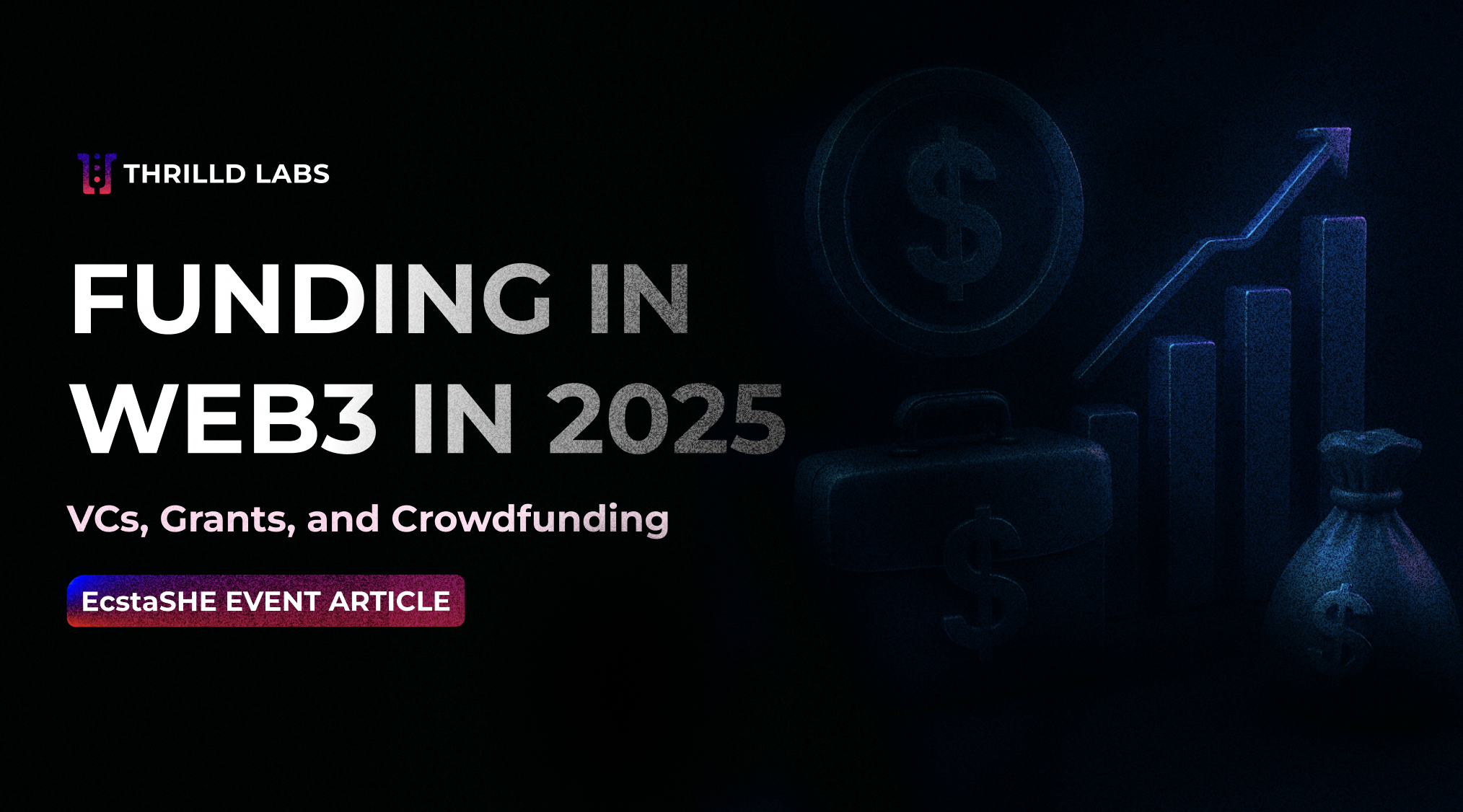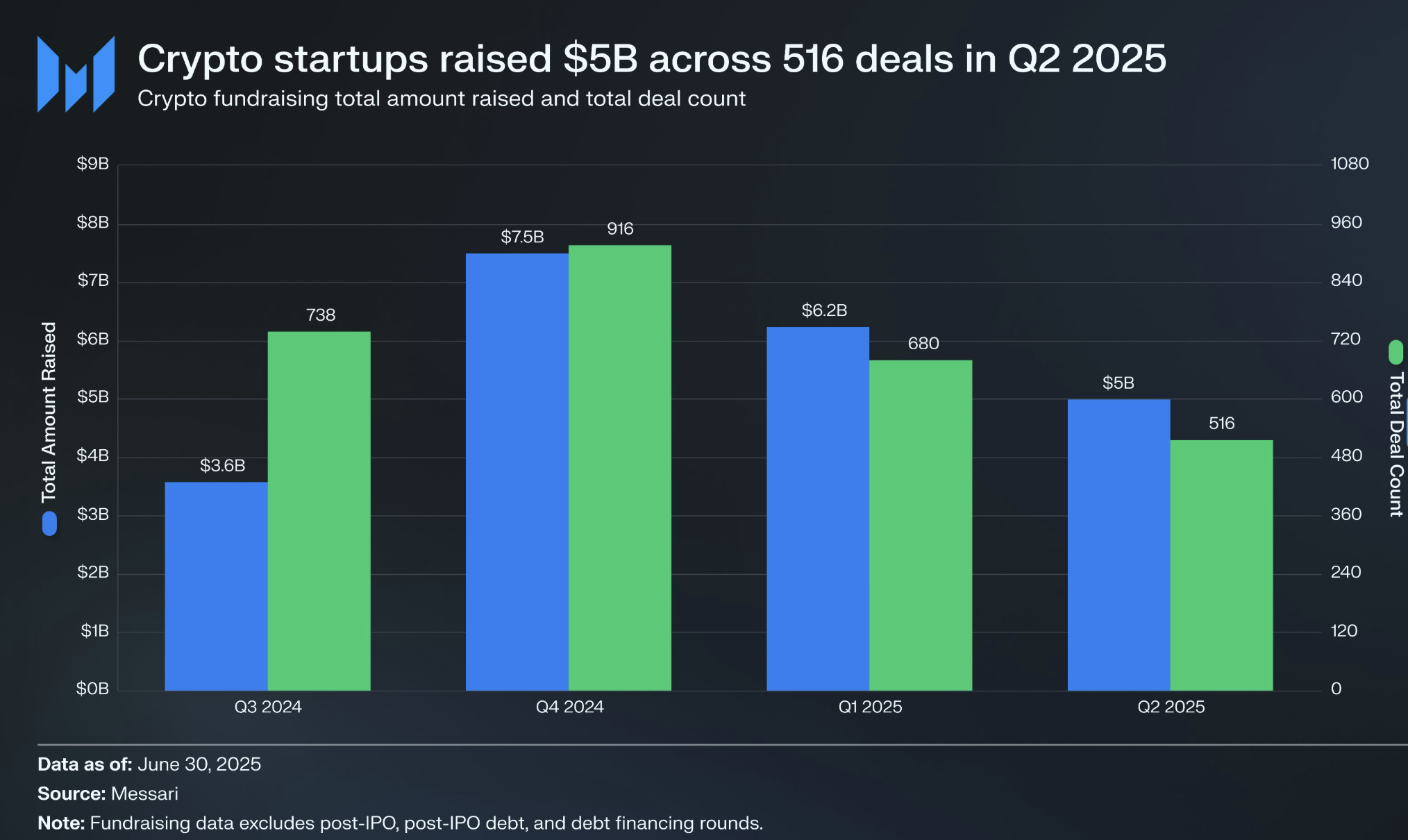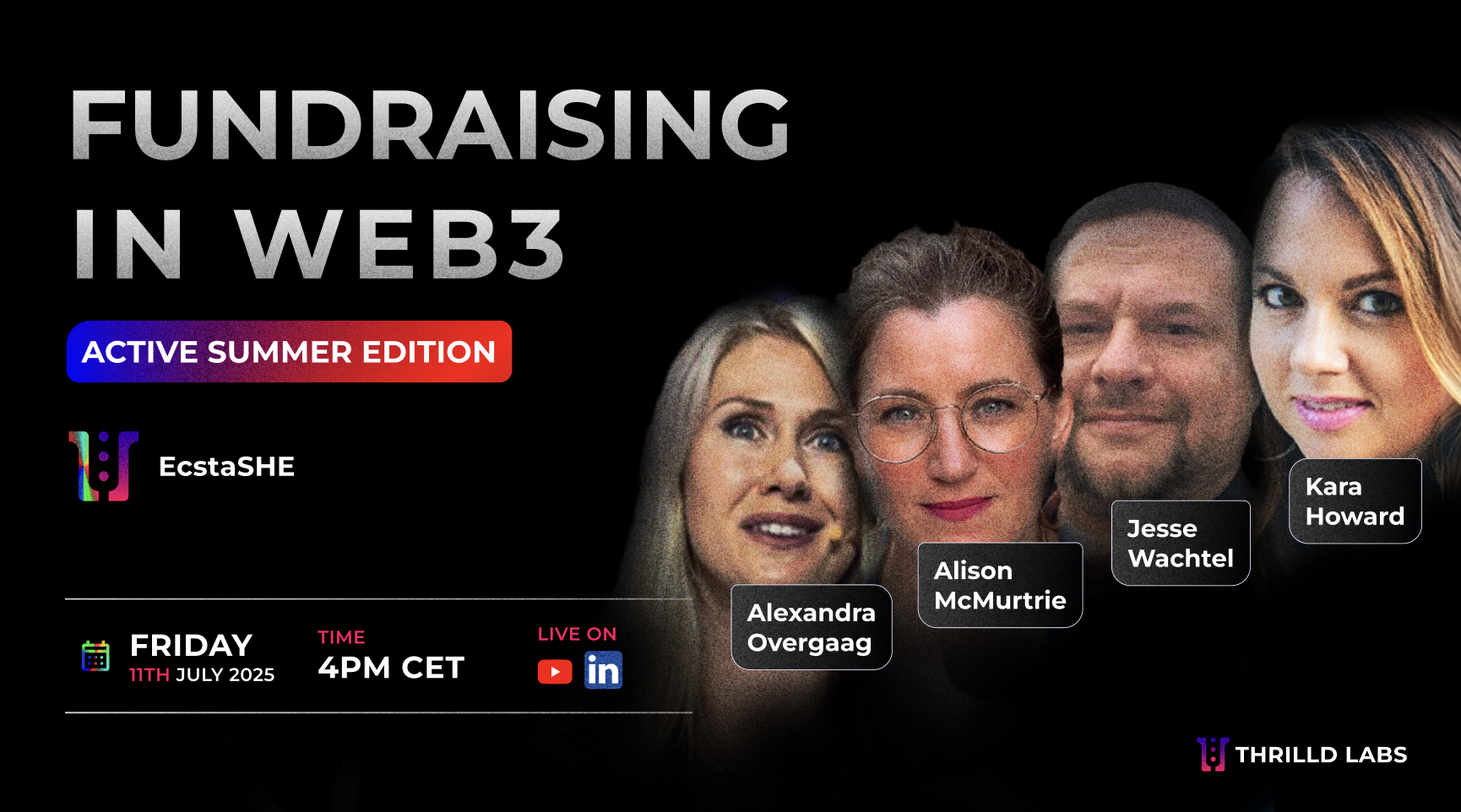Funding in Web3 in 2025: VC, Grants, and Crowdfunding
The Web3 ecosystem is evolving rapidly, and, as always, so is the discussion on how we fund it (and not fund it). High time for an updated 2025 discussion (based on our talk with REAL VCs and other funding experts) on the current status of grants, crowdfunding as well as REAL tips from real VCs on how to approach them and how to successfully land funding today. Read on.

In a July 2025 EcstaSHE event, Fundraising in Web3–Active Summer Edition, four founders and professionals working in Web3 discussed what fundraising is really looking like in 2025, and what are some of the best practices or pitfalls founders should look out for when it comes to landing (VC) investments, grants, and other types of what are essentially ways of funding a project. As part of the EcstaSHE live series, we also take a critical view at how women in particular are affected when securing funding and what are challenges that female-led companies face and how to solve them.
The event was hosted by Thrilld Labs' founder and CEO Alexandra Overgaag, and joined by the founder of Equisscore (purpose-focused VC for diverse and underrepresented founders in Europe and UK) Alison McMurtrie, co-founder and Ecosystem Growth at SI <3> Kara Howard, and the founder of Funding Chain and CTO of Thrilld Labs Jesse Wachtel. The talk flowed from thoughtful and honest discussion to at times provocative comments unpacking grants, VCs, angel investing, & crowdfunding, and the role of identity, and inclusion in what can be considered the funding game.
In this piece, we provide a brief overview of the main takeaways from the expert session alongside our own native research to hopefully reach a wider audience on what fundraising in Web3 really looks like in 2025…
Fundraising Realities in Web3

The Web3 ecosystem is evolving rapidly, and, as always, so is the conversation around how we fund it. Web3 fundraising has shifted significantly in recent quarters. Investor caution is rising, particularly in large fund rounds or less transparent markets. Meanwhile, AI and DeFi continue to attract capital in experimental or emerging niches. Mergers and acquisitions (M&A) also remain active.
However, Q2 2025data from Messari shows that VC activity is slowing and somewhat accumulating, with smaller and earlier rounds becoming less visible (whilst it does need to be mentioned that not all deals are included in the data, especially ealy stage deals, private or small deals, and deals not published in English ). Why? While liquidity might still be high in absolute numbers (total capital raised in Q2 fell 20% QoQ to $5B) investors are doing ever more due diligence in Web3 and there might be less risk appetite to stomach.
A VC Perspective: Quality Over Quantity
Alison, a VC fund co-founder, explained the point of view from the side of the investor, namely that when it comes to funding, doing your research is important. Firstly, is that geography matters. Raising capital through VCs doesn’t have the same process as say between Europe or the U.S. or compared to Asia. So, she suggests that founders need to understand regional preferences, regulation differences, and investor behavior.
On this last point, investor behavior is also shaped by the type of VC firm, either a crypto-native, forward-thinking VC looking for strong Web3 bets, or a skeptical and risk-averse VC needing education on why your project matters. Knowing your audience can be a deciding factor as it determines how you might frame a pitch. For this reason, Alison emphasizes that founders should personalize their outreach strategies by doing their homework and referring to shared content (i.e. “I saw you on the Thrilld Labs panel”...).
When it comes to VCs and funding, the focus is on what is perceived as quality. The VC is looking for projects that align with them in terms of goals, strategy, and also personality. One way founders can leave a better impression with a VC is by being prepared. The funding winter has filtered out noise, and the projects that remain have strong metrics, traction, and vision. For those, funding is still very possible, even in a tighter market.
And being prepared is only going to help the chances. Alison notes that this is an often underdiscussed point particularly relevant for today, as many Web3 startups are of far better quality. Competition is only increasing, making the standards go up, so coming ready becomes more a necessity.
To prepare, founders can build a clean, organized data room before reaching out (missing documents kill momentum). They should also come expecting due diligence while the project's online presence is audited. Aside from preparation when meeting with the VC, make also time for those unprepared moments, especially at industry ratherings... maybe ones that happen by chance or luck? Alison explains, “If you’re going to an event to hear talks, you’re doing it wrong. Go to meet people, and be ready to pitch in line for coffee”. The takeaway, when attending events, do so strategically, at charging stations, in the hotel lobby, and, of course on Thrilld…
Not all Web3 VCs are created equal. More tips on how to deal with VCs? Read more at “Dealing with VCs in the Web3 Space: a No-Nonsense 101 for Projects and Founders” on Thrilld Labs.
Grants' Evolution, Best Practices & Pitfalls
In the next topic, the panel turned to grants and how the Web3 grant landscape has matured. Kara Howard, co-founder of SI <3> and long-term grants expert, notes how early-stage grant rounds have characteristically been widely distributed, often with little accountability. Yet more recently, protocols are more selective, prioritizing longer-term impact, ecosystem alignment, and accountability or ROI. Grants are no longer limited to technical teams as she observes that marketers, community builders, and governance contributors are seeing more support.
While there is a clear shift in the grant scene from broader distribution to strategic depth, grants are going to projects with a track record aside from ideas alone. For projects, building a track record entails building out socially through marketing or community efforts, or by doing outreach. Build visibility. It is no longer enough to send in a GitHub link as in the early days. Rather, projects must focus on building a public presence and clear traction. Kara’s tip? Grants go to those who can articulate value, whether technical or community-orientated, and one way to do so is by joining a chain’s Discord or DAO. Attending governance calls and building relationships with protocol teams showcase publicly tangible actions and a genuine interest and commitment to the space and the project.
And what about the growing role of accelerators and incubators in Web3, as not just funding mechanisms but also on-ramps to knowledge, community, and credibility? Pairing grants with educational infrastructure may be especially helpful, particularly for non-technical founders or first-time builders. Yet the other side of the coin is that, as in the case of investor due diligence, one always have to be cautious.
Not all accelerators are founder-friendly. Some programs might ask for excessive equity in return for minimal support, or high upfront “application fees” or “success retainers”. Alexandra adds, “If someone asks for a big chunk of your equity before offering any value, that’s a red flag. Good accelerators are here to support. Don’t pick the ones that are overly keen to extract”. Thus, proper due diligence and caution comes up. Again.
How Decentralized Crowdfunding Goes Beyond Legacy Institutions
Then finally, what about funding coming from outside the institutions, so through decentralized crowdfunding? Leading the conversation on this topic, Jesse has created his own funding platform for projects, called Funding Chain. Funding Chain enables smart contract-based crowdfunding which allows users to raise funds without any gatekeepers, arguably a compelling look for many in the Web3 space and hopefully beyond.
Legacy fundraising platforms like Kickstarter or GoFundMe often censor or block campaigns for political or regional reasons. Moreover, some platforms require fees and intermediaries to transfer funds. That’s why Funding Chain uses Web3 infrastructure to ensure projects can raise money legally and freely, without middlemen. Beyond the intermediary-argument, raising funds without inherent obstacles in a community-based way can unlock capital for founders and others who do not fit traditional molds, such as technical founders, non-native English speakers, or people building for sensitive causes. Raising capital from your community may be easier than cold-pitching to VCs.
Jesse also notes “In Web3, the crowd is generous. If your idea resonates, they’ll fund you. No pitch decks, no suits”. So, crowdfunding is a viable, albeit often overlooked path, especially for early MVPs or impact-first and nonprofit initiatives. Additionally, grassroots validation can signal positively to future investors..What’s more, if an idea resonates strongly enough, a project can rapidly gain more attention and visibility through (community-based) crowdfunding.
A Note on Fundraising & Women in Web3
For this past International Women’s Day on March 8, 2025, we put together an article that looked at the role of women in tech and Web3, exploring topics like what positions they hold in the industry, what funding looks like for female-led teams, why women join (or not join) Web3, and what industry initiatives exist on the community level. While women are leading projects and succeeding in the industry, there is still a wide gap in the numbers of resources and positions that go to women in Web3. Less than 2% of VC capital goes to women-led startups, and in the grant space, most money goes to technical leads (90% of whom are male). Bias, conscious or not, is still very present in investor conversations.
As Alison noted, often women founders are met with questions such as “what does your husband think?” or “who will care for your children while you raise a Series A?”. A solution is to throw inappropriate matters right back at the investor. Alison McMurtie explains, “You need to flip the question back. Ask them: Who’s raising their kids while they run a fund?”. She added another tip: to simply ask for more. Female founders consistently under-ask, so the participants suggest that founders don’t just raise what they need, but raise for what they want to build.
It’s not about excluding men, it’s about finding shared values and creating a space for everyone. In a Thrilld Labs article, we even argue that “Web3 poses substantial opportunities for all participants, irrespective of gender, to engage in socio-economic systems.” (Women + Web3 – About a Merit-Based Space, Some Systemic Challenges, and a Fifth Wave of Feminism).
Conclusion
Despite the slight contraction in traditional funding, be it via VCs, grants, or accelerators, the energy and builder momentum in Web3 remains high. And we expect it will remain so, even in the next bear market. The space is seeing innovation in how capital is accessed (including in many ways not discussed in this article, such as launchpads, token raises and NFT sales) such as through decentralized crowdfunding, which is innovation within innovation. For those relying on more traditional avenues, due diligence remains key, especially in these times with AI. Read more about this at “Dealing with VCs in the Web3 Space: a No-Nonsense 101 for Projects and Founders”.
***
About the Panellists
Alison is co-founder and GP at emerging fund Equisscore, a fund which focuses on funding underrepresented founders with impact at the core of their startup. She herself is a serial entrepreneur, who is an active contributor in the start-up ecosystem, through iDunn Consulting where she serves as Founder and Principal. She also co-founded and served as the COO of CyberPie, a blockchain and AI focused cyber security startup which achieved successful investment and exit.
Kara has been an early advocate for decentralization and, for the past twelve years, she has formed inclusive communities and education platforms, forged partnerships and networks, and led professional development training. Kara is the Co-Founder and Ecosystem Growth Lead at SI <3> and is a DAO Contributor at Unlock Protocol DAO.
And from our own team, Jesse is the CTO of Thrilld Labs, where we’re building Web3 networking and event solutions. More importantly in this case, Jesse is also the founder of Decentralized Ventures, where he builds Web3 tools that merge usability with decentralization. One of those is Funding Chain, a censorship-resistant crowdfunding platform built for creators, activists, and communities that can’t rely on legacy platforms for fundraising.
Alexandra is the founder and CEO of Thrilld Labs, which builds Web3 networking and event solutions. She is also an advisor to BlockStart Scotland and Funding Chain, has been published (for instance, for the Cointelegraph), and is a mentor to various educational blockchain initiatives hosted by the Frankfurt School Blockchain Center. Her background is in law, political science, and the hospitality sector.
Join EcstaSHE
EcstaSHE is a female community, connecting action-oriented, professional female decision-makers in and around Web3 to enable networking and business collaborations. The EcstaSHE series is an initiative that organizes panel discussions or fire chats for community members or any interested participant to learn more about the Web3 ecosystem.
EcstaSHE members get prioritized access to conference tickets where Thrilld Labs provides giveaways. We also actively build speaking gigs, interviews, and business opportunities (at times) provided by our partners, whilst we also publish articles about business topics. We welcome women from diverse backgrounds, experiences, and expertise levels
To learn more about EcstaSHE and how to get involved, read more here or apply here.


